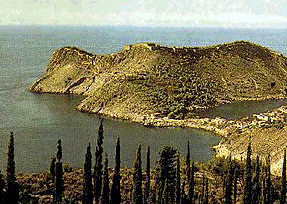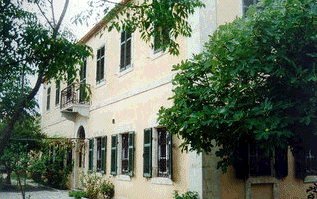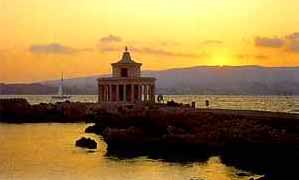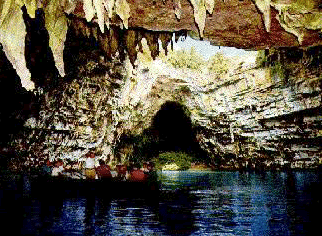|
|
Kefalonia Island
 Area: 782 sq. km Area: 782 sq. km
Population:
28.000
Argostoli area code : 26710
Police Station : 22.200
Argostoli Information Bureau : 22.248
Olympic Airways: 41.511
Menies Airport : 28.808, 28.881
Argostoli Port Authority : 22.224
Hospital : 22.434
Archaeological Museum : 28.300
Folk Art Museum : 28.835
Is the
largest of the lonian islands. Green rocks plunge suddenly
into the deep blue waters. Picturesque villages and small
beautiful towns highlighted by old mansions and
"humble" farmhouses; a little further over, the
ruins of some ancient city. Kefalonia has been justly called
the island of contrasts: Roman, Venetian, and Byzantine ruins,
side by side with famous beaches.
The capital
Argostoli is where the sea pours into spectacular
swallow-holes and disappears endlessly into subterranean
tunnels forming a rare geological phenomenon. The water
reappears at Lake Melissani, an incredible semi-underground
lake of clear turquoise and indigo water. Nearby is the
Drogarati cave, a large stalagmitic cavern of rare beauty. To
the north is the small village of Fiskardo, and its pretty
harbour, that has escaped the earthquakes and retains the old
style buildings.
History
of the island:
The history of Kefallonia is long and goes back for thousands
of years. The island has been inhabited since the Neolithic
times, as it is evident by findings discovered at the cave of
Drakena, near the village of Poros.
Some people
believe that Odysseus' (Ulysses') palace was actually in
Kefallonia, instead of the much smaller Ithaca that is next to
it. In general, Kefallonia's history is similar to that of the
other Eptanisa, as the Ionian Islands are called. In Classical
times, Kefallonia was allied with Athens. After the fall of
Greece, the island was conquered by Romans. There are remains
of a beautiful Roman villa, in the village of Skala, with a
very nicely preserved mosaic floor. After the decline of the
Greek and Roman empires and for many centuries, the island
fell prey to the pirates. Kefallonia came under the control of
the Italians during the 12th century, who governed it from
1185 to 1478. Venice, France, Turkey (very briefly) and
England were in succession the conquerors of Kefallonia until
1864.
 In 1864, as
a result of many years of social unrest and struggle by the
inhabitans, Kefallonia was united with Greece. The wonderful
Cultural museum in Argostoli, located under the Korgialleneia
Library, has invaluable exhibits from these periods. It is a
place you must visit and will be a fun and educational
experience for the whole family. Another museum to visit is
the Archeological museum, where one can see findings from
excavations at the island. In 1864, as
a result of many years of social unrest and struggle by the
inhabitans, Kefallonia was united with Greece. The wonderful
Cultural museum in Argostoli, located under the Korgialleneia
Library, has invaluable exhibits from these periods. It is a
place you must visit and will be a fun and educational
experience for the whole family. Another museum to visit is
the Archeological museum, where one can see findings from
excavations at the island.
Kefallonia
has a rich tradition in the arts, music and literature.
Fortunate enough to avoid the Ottoman rule, for any extended
period of time, the island was not isolated from the cultural
developments taking place in Europe. There are numerous
libraries at the island that are worth visiting, as they have
rare first editions on exhibit.
Magnificent Views:
Kefallonia is the largest of the Ionian islands (it covers an
area of 781 km2 and has a coastline of 254 km). Its
land is dominated by the Ainos mountain. In the North and
West, it has a ragged and beautiful coastline while in the
South and East there are large and sandy beaches, whith
crystal clear waters. Kefallonia has mild meditteranean
weather conditions, that make it wonderful to visit for most
of the year.
 The capital of the island is the town of Argostoli (pop.
7500). It is a lively place, especially in the summer months,
with much of the action taking place around its main square
(panoramic view, will take you to external site). Argostoli is
a modern town that offers many entertainment and shopping
opportunities, while still maintaining its charm. One of my
favorite things to do is taking an early morning walk on the
waterfront (panoramic view, will take you to external site).
Argostoli, as well as all the other towns and villages of the
island, were completely rebuilt after the devastating
earthquake that struck in 1953. The only area that was spared
from the earthquake was Fiskardo and for this reason it
retains the charm of the old architecture. The second largest
town of Kefallonia is Lixouri, on the Pali peninsula. The capital of the island is the town of Argostoli (pop.
7500). It is a lively place, especially in the summer months,
with much of the action taking place around its main square
(panoramic view, will take you to external site). Argostoli is
a modern town that offers many entertainment and shopping
opportunities, while still maintaining its charm. One of my
favorite things to do is taking an early morning walk on the
waterfront (panoramic view, will take you to external site).
Argostoli, as well as all the other towns and villages of the
island, were completely rebuilt after the devastating
earthquake that struck in 1953. The only area that was spared
from the earthquake was Fiskardo and for this reason it
retains the charm of the old architecture. The second largest
town of Kefallonia is Lixouri, on the Pali peninsula.
The port
of Sami, on the eastern side of the isle, is the main entry
point, due to the fact that it is opposite the Peloponnese
peninsula. The port of the capital Argostoli, on the western
side, is the most secure port of the Ionian Islands and a
perfect place to practice your sailing. The island is very
mountainous, with its highest peak, Mount Ainos, reaching 1628
m (5100 ft), which is also the highest of all the Ionian
Islands, and is covered by a rare black pine forest. There are
still some wild horses roaming its slopes (unfortunately their
numbers are declining) and the area is an official National
Park of Greece. On the lower elevations the hills are covered
with vineyards, that produce the famous Robolla wine. The
island has four large gulfs that are safe ports for boats. In
the north there is the Gulf of Myrtos, in the east that of
Sami, in the south that of Lourda, and in the west that of
Argostoli. In the area of the port of Sami, there are
interesting geological phenomena, like the Cave of Drongarati,
with stalagmites, and the cave of Melissani, with a
subterranean lake.
The caves are open to the public and if you are lucky you may
catch an orchestra performance in Drongarati, which has
fantastic acoustics. Another favorite visiting spot is
Karavomylos, where there are springs of sea water that has
traveled underground from the area of Katavothres, near
Argostoli, 35 km away. Kefallonia is one of the few places
where the rare turtle Kareta-Kareta lays its eggs.
 Visitor
Information:
You can read a great book about Kefallonia and its people
during WWII, by Louis De Bernieres, titled "Captain
Corelli's Mandolin" in the UK and "Corelli's
Mandolin" in the USA. It is the perfect book to take
along when you travel to the island. Kefallonia is fairly easy
to get to. The island is aproximately 20 nautical miles from
the port of Killini, on the coast of the Peloponnese and 50
nautical miles from the major port of Patra, that connects
Greece and Italy. Ferryboats connect the island with Killini
(1 hr 30 min) and with Patra (3 hrs 30 min) all year long. In
addition there are ferries that connect Kefallonia with the
islands of Zakynthos, Ithaca and Lefkada. You can also reach
Kefallonia by ferryboat from the Italian ports of Brindisi,
Ancona and Bari. There are Olympic Airways flights to and from
Athens (45 min) and the nearby island of Zakynthos (20 min).
During the summer months you can fly directly to Kefallonia,
with charter flights from many European cities. Visitor
Information:
You can read a great book about Kefallonia and its people
during WWII, by Louis De Bernieres, titled "Captain
Corelli's Mandolin" in the UK and "Corelli's
Mandolin" in the USA. It is the perfect book to take
along when you travel to the island. Kefallonia is fairly easy
to get to. The island is aproximately 20 nautical miles from
the port of Killini, on the coast of the Peloponnese and 50
nautical miles from the major port of Patra, that connects
Greece and Italy. Ferryboats connect the island with Killini
(1 hr 30 min) and with Patra (3 hrs 30 min) all year long. In
addition there are ferries that connect Kefallonia with the
islands of Zakynthos, Ithaca and Lefkada. You can also reach
Kefallonia by ferryboat from the Italian ports of Brindisi,
Ancona and Bari. There are Olympic Airways flights to and from
Athens (45 min) and the nearby island of Zakynthos (20 min).
During the summer months you can fly directly to Kefallonia,
with charter flights from many European cities.
Getting around the island requires some form of
transportation. If renting a car or a moped is something you
choose not to do, the public bus system KTEL is an easy and
inexpensive way to not only see most of the island, but to
meet the locals too.
So why visit Kefallonia? For starters, you will have a chance
to relax, if this is what you want, or you can enjoy the fun
and excitement of watersports (parasailing, water-skiing,
windsurfing, scuba etc.). If you like mountain biking, you
will not be disappointed. Nightlife provides for quiet dining
by the sea, pubs for music and drinking, Greek music clubs, as
well as nightclubs with the latest in European dance music.
The island is large enough and has enough to see, so that you
will not get bored after three days. It combines beautiful
beaches with mountainous and green terrain. It has a very good
infrastructure. The airport is newly renovated, the roads are
in good condition and for those with medical problems, the
hospitals of Argostoli and Lixouri are capable to handle all
medical emergencies. And to top it all off, it is cheaper to
visit and less crowded than other more popular destinations! |